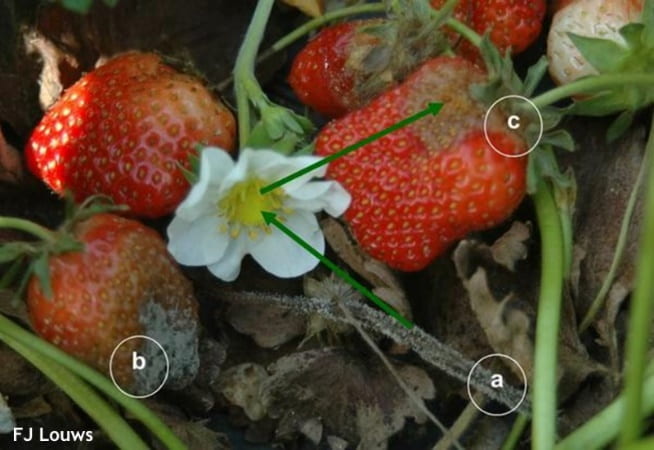Gordon Johnson, Extension Vegetable & Fruit Specialist; gcjohn@udel.edu
Strawberry growers in the region should initiate programs to control Botrytis fruit and crown rots in strawberries.
Gray mold of strawberry fruit is caused by the fungus Botrytis cinerea. This pathogen can also cause crown rots that can weaken or kill plants. The crown rot phase of the disease often develops under floating row covers that are used to promote growth or protect against cold events.
The reservoir for this fungus is mycelium in dead strawberry leaves. This mycelium becomes active in the spring and starts to produce spores on the old leaf tissue, which then spread to blooms. Most infections start at the bloom stage, but symptoms usually do not develop until close to harvest (the fungus does not become active until the fruit enlarges). Ripening fruits can also be infected. Conditions conducive for infection are temperatures between 70 and 80 °F and wet conditions (rain, dew, fog, irrigation). The most critical period for applying fungicides to control gray mold is during bloom.

Infection cycle of B. cinerea in strawberry plantings. Gray mold on different parts of strawberry; a) Sporulation on dead petiole and leaf; b) fruit infection from colonized dead tissue; c) fruit infection that came through the flower.
From Botrytis Fruit Rot / Gray Mold on Strawberry, NCState University https://content.ces.ncsu.edu/botrytis-cinerea-botrytis-fruit-rot-and-blight-on-strawberry
Fungicide Recommendations From our Commercial Production Recommendation Guide
Start spraying at 5-10% bloom, because most fruit infections occur through the flower. Repeat every 7-10 days. Spray less frequently during prolonged dry periods but spray every 5-7 days during very wet periods. Base resistance management on protectants captan and thiram and add in a site-specific fungicide (e.g., Elevate or Switch) to the protectants when weather conditions turn favorable for disease. Except for Captan and Thiram, do not use the same FRAC code more than twice per season. FRAC 2 products (e.g., Rovral) need to be applied before first fruiting flower and can only be applied once per season. Risk of resistance to FRAC 17 (Elevate) and 2 (e.g., Rovral) is high. The active ingredient boscalid in Pristine fungicide has the least intrinsic activity compared with other fungicides within the FRAC 7 code. If a product like Pristine is used for Anthracnose Fruit Rot control, this can also reduce Gray Mold due to the presence of boscalid in it. High risk of Botrytis infection is estimated with weather-based models recommended by the Strawberry Advisory System and NEWA.
|
FRAC Code |
Product Name (*=Restricted Use) | Product Rate | Active Ingredient(s) |
PHI (d) |
REI (h) |
Bee TR |
| Apply Captan or Thiram solely when disease pressure is low to moderate. Captan is a better choice if Anthracnose is a concern or is present. | ||||||
| M03 | Thiram SC | 2.5 qt/A | thiram | 1 | 24 | — |
| M03 | Thiram Granuflo | 4.4 lb/A | thiram | 3 | 24 | — |
| M04 | Captan 50W | 6.0 lb/A | captan | 0 | 24 | N |
| M04 | Captan 80WDG | 3.7 lb/A | captan | 0 | 24 | N |
| M04 | Captan 4L | 3.0 qt/A | captan | 0 | 24 | N |
| M04+17 | Captevate 68WDG1 | 3.5 to 5.25 lb/A | captan + fenhexamid | 0 | 24 | N |
|
Use the following fungicides when disease pressure is high. Apply them with a tank-mix partner (captan or thiram) may help with resistance management. Do not apply the same FRAC code more than twice in a row or in a season (e.g., Cabrio and Pristine contain the same FRAC code). |
||||||
| 2 | Meteor2 | 1.5 to 2.0 pt/A | iprodione | n/a | 24 | N |
| 2 | Nevado 4F2 | 1.5 to 2.0 pt/A | iprodione | n/a | 24 | N |
| 2 | Rovral 4F2 | 1.5 to 2.0 pt/A | iprodione | n/a | 24 | N |
| 7 | Fontelis 1.67SC | 16 to 24 fl oz/A | penthiopyrad | 0 | 12 | L |
| 7 | Kenja 400SC3 | 13.5 to 15.5 fl oz/A | isofetamid | 0 | 12 | — |
| 7 + 9 | Luna Tranquility 4.16SC | 16 to 27 fl oz/A | fluopyram + pyrimethanil | 1 | 12 | — |
| 7 + 11 | Luna Sensation 4.25SC | 6 to 7.6 fl oz/A | fluopyram + trifloxystrobin | 0 | 12 | — |
| 7 + 11 | Pristine 38WG | 18.5 to 23 fl oz/A | boscalid + pyraclostrobin | 0 | 12 | M |
| 7 + 11 | Merivon Xemium | 8 to 11 fl oz/A | fluxapyroxad + pyraclostrobin | 0 | 12 | N |
| 7 +12 | Miravis Prime | 9.1 to 13.4 fl oz/A | pydiflumetofen + fludioxinil | 0 | 12 | — |
| 9 | Scala 5SC | 18 fl oz/A, if alone | pyrimethanil | 1 | 12 | — |
| 9 + 12 | Switch 62.5WG | 11 to 14 oz/A | cyprodinil + fludioxonil | 0 | 12 | L |
| 17 | Elevate 50 WDG | 1.5 lb/A | fenhexamid | 0 | 12 | N |
1Do not tank mix Captevate with Elevate. Captevate is no longer manufactured so supplies are limited. 2Do not make more than 1 application/season. Do not apply these products after first fruiting flower. 3Except for the varieties Clancy, Jewel, and L’Amour.
